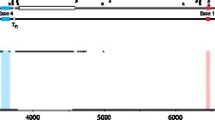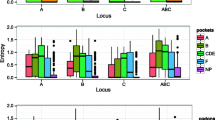Summary
The systematic study of heterozygotes for the g locus controlling G serotype in Paramecium aurelia syngen 1, shows that a phenomenon of allelic exclusion exists. This phenomenon of exclusion happens either systematically, almost systematically or randomly, depending on the studied combination of alleles (Table 2). For a given combination of alleles, it is always the same allele which is “excluded”. Back-cross experiments indicate that the observed allelic modulation is not dependent upon a simple or classical type of regulatory system. It seems to be characteristic of a given allelic interaction.
This phenomenon of allelic exclusion resembles the well-known phenomenon of mutual exclusion occurring between different loci which govern the surface antigens corresponding to the different serotypes of Paramecium aurelia. Both cases of exclusion (inter-allelic or intergenic) might involve an original mechanism of inter-regulation between proteins belonging to the same molecular “family” and fulfilling similar functions but under different physiological conditions.
Similar content being viewed by others
References
Baglioni, C.: In: Molecular genetics, part 1, Taylor J. H. ed. New York and London: Academic Press 1963.
Beale, G. H.: Antigen variation in Paramecium aurelia, variety 1. Genetics 37, 62–74 (1952).
Beale, G. H.: The genetics of Paramecium aurelia. Salt, Cambridge: University Press 1954.
—: The antigen system of Paramecium aurelia. Int. Rev. Cytol. 6, 1–23 (1957).
Beisson, J., Rossignol, M.: The first case of linkage in Paramecium aurelia. Genet. Res. 13, 85–90 (1969).
Capdeville, Y.: Sur les interactions entre allèles contrôlant le type antigénique G chez Paramecium aurelia. C.R. Acad. Sci. (Paris) 269, 1213–1215 (1969).
Cebra, J. J., Colberg, J. E., Dray, S.: Rabbit lymphoid cells differentiated with respect to α-γ, and μ, heavy polypeptide chains and to allotypic markers AA1 and AA2. J. exp. Med. 123, 547–555 (1966).
Chiappino, G., Pernis, B.: Demonstration with immunofluorescence of 19 S macroglobulin and 7 S gamma globulin in different cells of the human spleen. Path. and Microb. 27, 8 (1964).
Dryl, S.: Antigenic transformation in Paramecium aurelia, after homologous antiserum treatment during autogamy and conjugation. J. Protozool. 6 (Suppl.), 25, (1959).
Finger, I.: The inheritance of the immobilization antigens of Paramecium aurelia, variety 2. J. Genet. 55, 361–374 (1957).
— Heller, C.: Immunogenetic analysis of proteins of Paramecium IV-Evidence for presence of hybrid antigens in heterozygotes. J. molec. Biol. 6, 190–202 (1963).
—: Cytoplasmic control of gene expression in Paramecium. I. Preferential expression of a single allele in heterozygotes. Genetics 49, 485–498 (1964).
— Green, A.: Immunogenetic analysis of proteins of Paramecium. II. Coexistence of two immobilization antigens within animals of a single serotype. Genetics 47, 241–253 (1962).
— Onorato, F., Heller, C., Wilcox, H. B.: Biosynthesis and structure of Paramecium hybrid antigen. J. molec. Biol. 17, 86–101 (1966).
Jacob, F., Monod, J.: Genetic regulatory mechanisms in the synthesis of proteins. J. molec. Biol. 3, 318–356 (1961).
Jones, I. G.: Immobilization antigen in heterozygous clones of Paramecium aurelia. Nature (Lond.) 207, 769 (1965).
Margolin, P.: An exception to mutal exclusion of the ciliary antigens in Paramecium aurelia. Genetics 41, 685–699 (1956).
Nanney, D. L., Nagel, J., Touchberry, R. W.: The timing of H antigenic differentiation in Tetrahymena. J. exp. Zool. 155, 25–42 (1964).
Pernis, B., Chiappino, G., Kelus, A. S., Gell, P. G.: Cellular exclusion of immunoglobulin with different allotypic specificities in rabbit lymphoid tissue. J. exp. Med. 122, 853–876 (1965).
Philips, R. B.: The serotype differenciation in Tetrahymena. Genetics 56, 683–692 (1967).
Preer, J. R., Jr.: Studies on the immobilization antigens of Paramecium; IV. Properties of the different antigens. Genetics 44, 803–814 (1959).
—: Research in protozoology, vol. 3, ed. Tze-Tuan Chen. Oxford-New York: Pergamon Press 1968.
Sommerville, J.: In: Advances in microbial physiology vol. 4, Rose, A. H., Wilkinson, J. F. ed. London: Academic Press 1970.
Sonneborn, T. M.: Recent advances in the genetics of Paramecium and Euplotes. Advanc. Genet. 1, 264–358 (1947).
—: The determination of hereditary antigenic differences in genetically identical Paramecium cells. Proc. nat. Acad. Sci. (Wash.) 34, 413–418 (1948).
—: Methods in the general biology and genetics of Paramecium aurelia. J. exp. Zool. 113, 87–143 (1950a).
—: The cytoplasm in heredity. Heredity 4, 11–36, (1950b).
Author information
Authors and Affiliations
Additional information
Communicated by P. Slonimski
Rights and permissions
About this article
Cite this article
Capdeville, Y. Allelic modulation in Paramecium aurelia heterozygotes. Molec. Gen. Genetics 112, 306–316 (1971). https://doi.org/10.1007/BF00334432
Received:
Issue Date:
DOI: https://doi.org/10.1007/BF00334432




